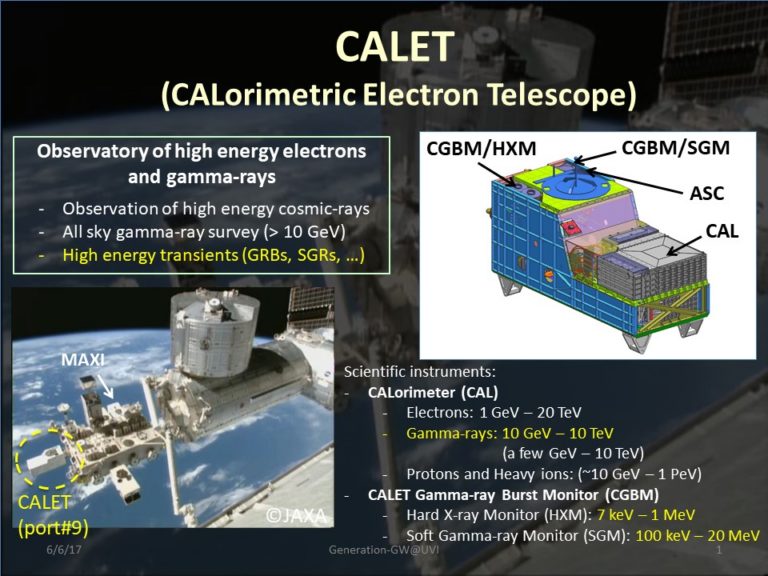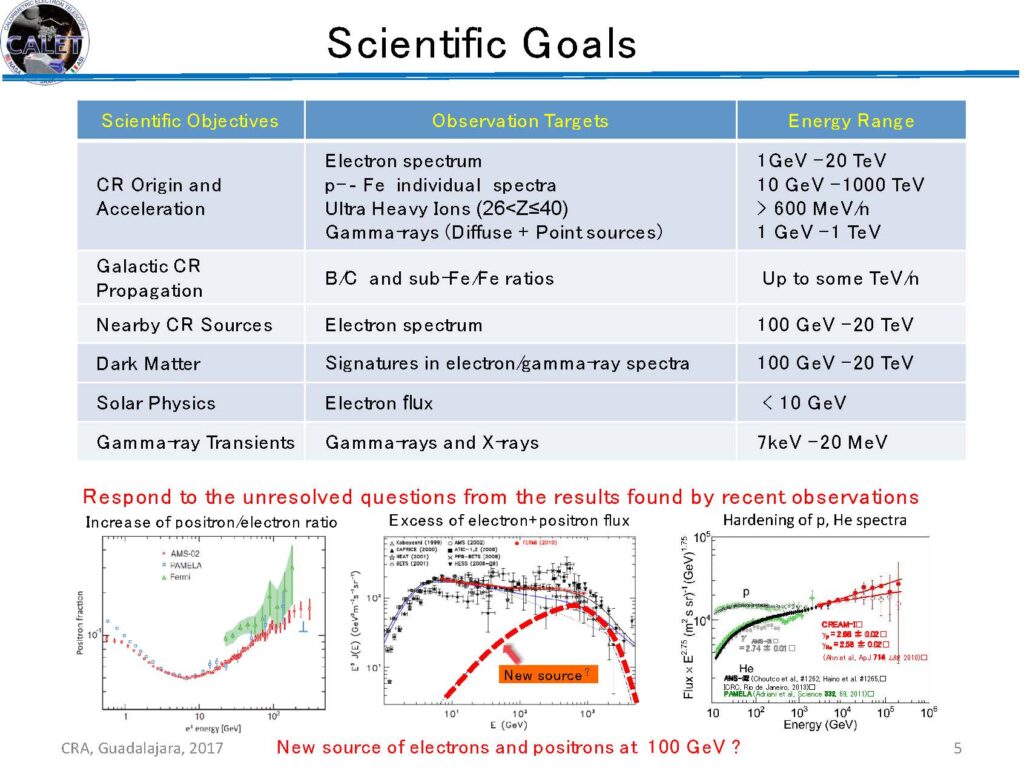CALorimetric Electron Telescope (CALET) on the ISS
The CALET mission is designed to investigate the High Energy Universe, as a next generation experiment to build upon discoveries made by Fermi, PAMELA, AMS, Atmospheric Cherenkov Telescopes (ACT) and balloon instruments. CALET is a calorimeter-based instrument with superior energy resolution and excellent separation between hadrons and electrons and between charged particles and gamma rays. With these capabilities, it will be possible for CALET to address many of the outstanding questions in High Energy Astrophysics (HEA) including (1) signatures of dark matter in either the high energy electron or gamma ray spectrum, (2) the nature of the sources of high energy particles and photons through the high energy electron spectrum, and (3) the details of particle propagation in the galaxy by a combination of energy spectrum measurements of electrons, protons and higher-charged nuclei. Thus, CALET can be thought of as an HEA “observatory”.

CALET, an acronym for CALorimetric Electron Telescope, is a Japanese-Italian-US mission developed as part of the utilization plan for the International Space Station (ISS). CALET was launched Aug. 19, 2015 on an H2 rocket utilizing the Japanese-developed HTV (H-IIA Transfer Vehicle) and robotically attached to the Exposure Facility attached to the Japanese Experiment Module (JEM-EF) (Figure 1).
CALET is funded by JAXA in Japan, ASI in Italy, and NASA in the US. The US institutions consist of Lead Institution Louisiana State University, NASA Goddard Space Flight Center, Washington University in St. Louis.


CGBM: a gamma-ray burst monitor on CALET
CGBM results are currently been updated. Check back later for more exciting results.
CALET Instrument Successfully Launched to Space Station, Aug. 2015
The CALorimetric Electron Telescope (CALET) instrument launched to the International Space Station (ISS) aboard the HTV-5 vehicle on 19 August at about 10 pm JST (8 am CST) from the Tanegashima Space Center off the southern coast of Japan. An H-IIB rocket will launch the H-II Transfer Vehicle, named Kounotori-5. CALET was transferred to the Exposed Platform attached to the Japanese Experiment Module, Kibo. There it has been measuring very high energy cosmic ray electrons, nuclei and gamma rays for just over 10 years. The launch and ISS rendezvous can be viewed on youTube. Prof. Cherry represented LSU at the launch.
CALET arrives at Space Station Aug. 24, 2015
A Japanese led international mission, CALET involves nearly 50 researchers from Japan, Italy and the USA. LSU leads the US Science Team consisting of LSU, Washington University in St. Louis, NASA Goddard Space Flight Center and hosts the US CALET Data Center. John P. Wefel, late LSU Professor Emeritus of Physics and Astronomy and US Co-Principal Investigator for CALET at the time of launch said “This mission is a tribute to the importance of international scientific research.” And added, “CALET is a great instrument and we expect to make new astrophysical discoveries with the rich dataset the mission will provide. The new insights into the workings of powerful astrophysical particle accelerators can teach us how to develop better accelerating machines here on the ground. In addition, CALET may observe a signature of the elusive dark matter.”
CALET will measure the intensity of cosmic ray electrons, protons, and nuclei accelerated to near the speed of light, and also observe high energy gamma rays. The main CALET telescope consists of an array of scintillation detectors to determine the electric charge of the incoming cosmic ray particles, an imaging calorimeter of scintillating fibers to determine the particle trajectory, and a deep lead tungstate calorimeter to measure particle and gamma ray energies up to 20 Tera-electron volts, a factor of more than three times higher than the particle beams at the largest manmade accelerator on Earth, the Large Hadron Collider in Switzerland. At such high energies, CALET may be the first experiment to observe a ‘near-by’ source of high energy radiation. LSU scientists will operate the US CALET Data Center (USCDC) linking to Japan (and Italy), to obtain and process the flight data, distribute the results to the other US institutions, and serve as a central site for the data analysis.
CALET is funded in the US by NASA, in Italy by the Italian Space Agency (ASI), and in Japan by the Japan Aerospace Exploration Agency (JAXA).